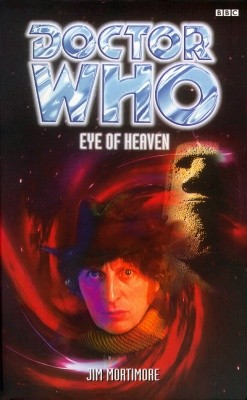BASIC PLOT
Thirty years ago, Horace Stockwood's anthropological mission to
Rapa Nui -- Easter Island, or The Eye Which Sees Heaven -- went
horribly, tragically wrong. Now Stockwood wants to return to the
island to make amends for a liftime of guilt and manages to secure the
sponsorship of the Doctor and the friendship of his warrior companion,
Leela.
DOCTOR
Fourth.
COMPANIONS
Leela.
MATERIALISATION CIRCUIT
Portsmouth, August 21 1872. The TARDIS is accidentally loaded onto
a ship bound for India and not recovered within the confines of this
book, but as the Doctor says "We'd run into each other again soon; it
was a small enough planet." (pg 78)
PREPARATORY READING
The Face of Evil.
CONTINUITY REFERENCES
There are references to Face of Evil all over the place,
with Leela's family and tribe, plus the rituals of the survey team,
the Tesh etc. Leela uses a lot of words that originate from the survey
mission, such as the "Xaust wind" and "Cryuni", the bringer of death
(a contraction of cryogenic units). Parts of the litany of the
sevateem are recited in Leela's dreamscape in Chapter 23, taken
directly from Face of Evil.
Pg 49 Reference to Talons of Weng Chiang. Leela mentions
having encountered a horse recently, but isn't sure since she was
fighting for her life at that point.
Pg 179 "There are certain silicon-based life forms at large in the
galaxy and I wanted to make sure we were not dealing with something
like that here. The Ogri insinuate themselves into primitive cultures,
quite often masquearing as sacrificial stones. They don't move very
quickly, you see. And they feed on human blood. Protective camouflage.
Darwin was right, you see, and not just about this planet." The
Stones of Blood.
Pg 214 The Doctor recovers from being shot by remembering the events
with Master Padmasambhava and the holy ghanta, from the backstory to
The Abominable Snowmen
OLD FRIENDS AND OLD ENEMIES
None.
NEW FRIENDS AND NEW ENEMIES
Horace Stockwood, James Royston.
CONTINUITY COCK-UPS
- The references to the Ogri pre-date The Stones of Blood in the
Doctor's timeline.
PLUGGING THE HOLES [Fan-wank theorizing of how to fix continuity cock-ups]
- The Doctor may just have had an unseen adventure with the Ogri, or
heard about them without encountering them.
FEATURED ALIEN RACES
The unnamed race who created the moai to ensure their survival
from invaders (and whose genetic material is coded into the natives of
Rapa Nui). We only see their history, as explained in Chapter 25.
FEATURED LOCATIONS
Rapa Nui, October 1852, December 1872, December 1902.
London, August 1872. Aboard the Tweed sailing ship, August-December
1872
A countless number of alien worlds that Leela and Stockwood travel
through via the Moai in Chapter 19.
The original alien world which created the moai and sent them out
across the universe with encrypted genetic material (one of which
landed on Rapa Nui on Earth).
The Doctor and Leela journey on a ship with naturalist and painter
Marie Anne North, bound for India.
THE TIMELINE
Eye of Heaven features an unusual structure, with the
chapters out of order. The linear story is told in the Prologue, then
Chapters 2, 4, 6, 8, 10, 12, 14 telling the story of the events in
London, leading up to the launching of the Tweed and its possession by
Jennifer Richards. Chapters 3, 5, 7, 9, 11, 13 tell the story of the
journey from England to Rapa Nui. In Part Two, Chapters 16, 18, 20,
22, 24, 26, 28 tell the story of the attack by the Peruvian slavers
and then Chapters 15, 17, 19, 21, 23, 25, 27 and then the epilogue
tell the story of the discovery of the dead world on the other side of
the wormhole and the effects that Stockwood's original journey had on
the alien civilisation. Chapter 15 is the misleading one here: Leela's
dream of the vortex is not related to the tornado we just saw in
Chapter 13, but is rather the effect of travelling through the
wormhole at the end of Chapter 27.
The chapters, with their first person POV, are out of order for
thematic reasons: It all comes together in the juxtaposition of
chapters 27 and 28 (which in a linear story would be seven chapters
and a quarter of the novel apart). Jennifer Richards is as consumed
with revenge as Horace Stockwood is with guilt, both stemming from the
death of Alexander Richards. On page 255 Leela makes a speech about
the uncertainty principle (which mirrors Stockwood's attempts to
observe a culture inadvertently changing it and causing the deaths of
billions on the alien world) and the importance of dealing with grief
and moving on with life. Stockwood survives, because he realised that
life was what was important and he had wasted his on grief, whereas in
the "next" Chapter, Richards kills herself, unable to let go of the
revenge and rejoice in her life, as Leela tells her to. Richards'
death is the last chapter in the linear progression, but the final
chapter in the book shows Richards wounded and the Doctor taking her
through the wormhole to save her. Topeno tells the Doctor that
Richards' life is not important, but the book ends with the Doctor
furious, saying "Every life is important, Topeno. Do you hear me?
Every life!"
IN SUMMARY - Robert Smith?
In every sense of the word, Eye of Heaven is a novel. It's
complex, mature, plotted like a dream and has some of the best
characterisation of any Doctor Who character ever in the first person
narrative of Leela. There are four separate but intertwined stories
going on here and Mortimore assumes we're intelligent enough to follow
along. It's a fabulous book, taking all the Mortimore trademarks and
making them work. This is the book that puts most other PDAs to shame,
by showing us just how good the series can be when it wants to.

